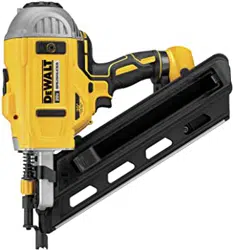Loading ...
Loading ...
Loading ...

ENGLISH
3
into account the working conditions and the
work to be performed. Use of the power tool for
operations different from those intended could result
in a hazardoussituation.
5) Battery Tool Use and Care
a ) Recharge only with the charger specified by the
manufacturer. A charger that is suitable for one type
of battery pack may create a risk of fire when used
with another batterypack.
b ) Use power tools only with specifically designated
battery packs. Use of any other battery packs may
create a risk of injury andfire.
c ) When battery pack is not in use, keep it away
from other metal objects, like paper clips, coins,
keys, nails, screws, or other small metal objects,
that can make a connection from one terminal to
another. Shorting the battery terminals together may
cause burns or afire.
d ) Under abusive conditions, liquid may be ejected
from the battery; avoid contact. If contact
accidentally occurs, flush with water. If liquid
contacts eyes, additionally seek medical help.
Liquid ejected from the battery may cause irritation
orburns.
6) Service
a ) Have your power tool serviced by a qualified
repair person using only identical replacement
parts. This will ensure that the safety of the power
tool ismaintained.
Nailer Safety Warnings
• Always assume that the tool contains fasteners.
Careless handling of the nailer can result in unexpected
firing of fasteners and personalinjury.
• Do not point the tool towards yourself or anyone
nearby. Unexpected triggering will discharge a fastener
causing aninjury.
• Do not actuate the tool unless the tool is placed
firmly against the workpiece. If the tool is not in
contact with the workpiece, the fastener may be deflected
away from yourtarget.
• Disconnect the tool from the power source when the
fastener jams in the tool. While removing a jammed
fastener, the nailer may be accidentally activated if it is
pluggedin.
• Use caution while removing a jammed fastener. The
mechanism may be under compression and the fastener
may be forcefully discharged while attempting to free a
jammedcondition.
• Do not use this nailer for fastening electrical cables.
It is not designed for electric cable installation and may
damage the insulation of electric cables thereby causing
electric shock or firehazards.
Additional Nailer Safety Warnings
WARNING: When using any nailer, all safety
precautions, as outlined below, should be followed
to avoid the risk of death or serious injury. Read and
understand all instructions before operating thetool.
• Keep hands and body parts away from the discharge
area of the tool. While in use NEVER grasp the tool by the
magazine or canister, a mis-driven nail can exit the nose
causing injury.
• Hold tool by insulated gripping surfaces when
performing an operation where the cutting tool
may contact hidden wiring. Contact with a “live” wire
will make exposed metal parts of the tool “live” and shock
theoperator.
• Actuating tool may result in flying debris, collation
material, or dust which could harm operator’s
eyes. Operator and others in work area MUST wear
safety glasses with side shields. These safety glasses
must conform to ANSI Z87.1 requirements (approved
glasses have “Z87” printed or stamped on them. It is
the employer’s responsibility to enforce the use of eye
protection equipment by the tool operator and other
people in the workarea.
• Always wear appropriate personal hearing and
other protection during use. Under some conditions
and duration of use, noise from this product may
contribute to hearingloss.
• Disconnect battery pack from the tool when not in
use. Always remove battery pack and remove fasteners
from magazine before leaving the area or passing the
tool to another operator. Do not carry tool to another
work area in which changing location involves the use
of scaffoldings, stairs, ladders, and the like, with battery
pack connected. Do not make adjustments, perform
maintenance or clear jammed fasteners while battery is
inplace.
• Do not remove, tamper with, or otherwise cause the
tool, trigger or trigger lock-off, to become inoperable.
Do not tape or tie trigger in the on position. Do not remove
spring from contact trip. Make daily inspections for free
movement of trigger. Uncontrolled discharge couldresult.
• Inspect tool before use. Do not operate a tool if any
portion of the tool, trigger, or trigger lock-off is
inoperable, disconnected, altered, or not working
properly. Damaged parts or missing parts should be
repaired or replaced before use. Refer toRepairs.
• Do not alter or modify the tool in anyway.
• Always assume that the tool containsfasteners.
• Do not point the tool at co-workers or yourself at
any time. No horseplay! Work safe! Respect the tool as a
workingimplement.
• Keep bystanders, children, and visitors away while
operating a power tool. Distractions can cause you to
lose control. When tool is not in use, it should be locked in
a safe place, out of the reach ofchildren.
• Always use trigger lock-off when tool is not in
immediate use. Using the trigger lock-off will prevent
accidentaldischarge.
• Do not overreach. Maintain proper footing and balance
at all times. Loss of balance may cause personalinjury.
Loading ...
Loading ...
Loading ...
